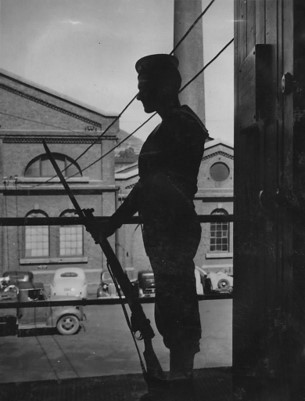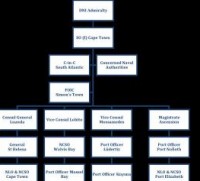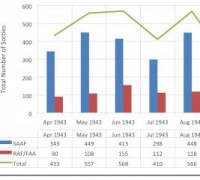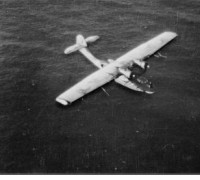THE AXIS AND ALLIED MARITIME OPERATIONS AROUND SOUTHERN AFRICA 1939 1945 - WAR ON SOUTHERN AFRICA SEA
28)THE SECURITY SECTION
4.3.3 The Security Section
In September 1939, Ransome’s staff was increased to include a Defence Security Officer (Naval) (DSO (N)). Initially, the DSO (N) was mainly concerned with the monitoring of known communists while keeping a comprehensive record of suspected enemy agents and subversive elements within South Africa. Shortly after the offices of the SO (I) Cape Town moved to Seaward House, there was a marked increase in naval information passed on to the CNIC from South Africans loyal to the war effort and the Smuts Government. These citizens reported on those parts of South African society who actively worked against the Union’s war effort in the naval sphere. Of particular interest were those in the employ of the SAP, the UDF and the broader Public Service.[1] All Security Officers from naval vessels berthed in Cape Town were required to report to the DSO (N) upon arrival, who conveyed all anti-sabotage information and provided a detailed overview of the current political situation in the Union. The DSO (N) also initiated local deception plans to disguise the future movements of all naval and merchant shipping.[2]
In December 1939, all South African harbours and adjoining dockyards – bar Simon’s Town, which fell under British legislation – were declared prohibited areas under Section 85 of the South African Defence Act of 1912.[3] The legislation furthermore outlined the duties and responsibilities of the various Dock commandants and their staff. The introduction of entry and exit permits to dockyards, as well as the issuing of boarding permits for naval vessels, helped to control the movement of personnel at Union harbours. This system remained in operation until March 1942. After this, the Dock Commandants and SANF agreed to a system of Naval Identity Cards for Officers, and Pay and Identity Books for Naval Ratings wishing to gain access to dockyards and for boarding shipping. Henceforth, boarding permits were required for all civilians wishing to board naval vessels as well. The SAR&H Police also guarded all entrances to the dockyards and scrutinised boarding passes and permits. This system, however, created a shortage of SAR&H Police for patrols within the inner docks.[4]
The creation of the Essential Service Protection Corps in 1939, largely made up of military veterans, helped to guard key installations both within and outside the docks and other important installations in the Union. Guards were placed on the gangways of all merchant shipping. These guards also mainly consisted of ex-soldiers, who were vetted by both the Criminal Investigation Department of the SAP and the DSO (N) up to 1942, whereafter the Port Security Police took over this responsibility.[5]
By mid-October 1942, Smuts had instructed Defence Headquarters to form a dedicated Port Security Force, upon the recommendation of Col W.H.A. Webster – the former MI5/MI6 representative in the Union. Several representatives of the concerned Departments and Services attended the meeting held in Pretoria during October and discussed all existing protective measures in force at union ports since the outbreak of war.[6]
The meeting agreed that the new GOC Coastal Area Command assume complete control over the field security at each Union harbour. Control over field security would be similar to that which existed in British ports, though amended for South African conditions, and each concerned Department/Service would continue functioning as at present. The main functions of the Field Security Unit would be counterespionage work, the prevention of the leakage of sensitive information, the investigation and prevention of sabotage, and the interrogation of suspects. In addition, a senior Railway Officer, with intimate knowledge of railway and harbour conditions in the Union was appointed. This person fromed part of the staff of the GOC Coastal Area Command, and acted as a liaison officer in lieu of harbour defence.[7]
The appointment of Directors of Port and Shipping at Cape Town and Durban, and Dock Commandants at East London and Port Elizabeth, occurred at the beginning of November 1942.[8]
The Directors of Port and Shipping also all acted as liaison officers. On 26 November 1942, an Internal Security Meeting of the Cabinet was held in Pretoria. Here, it was decided that the new Port Security Organisation would comprise of committees at each Union port, and would replaced the now defunct Intelligence Records Bureau. These committees would consist of representatives from Naval Intelligence, Military Intelligence, Naval Censorship, Essential Service Protection Corps, Dock Commandants, Railway Police, SAP and officials from Customs and Immigration. Later on, representatives from the Ministry of War Transport (MWT) and War Shipping Administration, as well as the US Naval Attaché, sat in on these meetings. The objectives of these committees were to discuss all problems relating to the security of ports and shipping and to establish collective measures which would improve the security at each port. They would also to keep the GOC Coastal Area Command informed of all matters which affected port security. This would be executed through the respective Fortress Commanders. To its credit, the Port Security Organisation functioned successfully from the time of its formation until the end of the Second World War.[9]

Fig 4.10: A guard aboard a merchant ship at a South African harbour during the war[10]
During the war, cases of sabotage and suspected sabotage in the naval sphere were dealt with in two distinct ways. First, a special committee convened by each harbour’s administration, handled sabotage cases involving docked merchant shipping. Second, sabotage cases detailed by vessels at sea were the concern of the MWT or the naval authorities at the port where first reported. In each case, however, the DSO (N) forwarded any reports of sabotage to the Admiralty for information. After January 1944, all sabotage accounts were also forwarded to the Director-General of MI5 for information. Following the commencement of the German submarine operations in South African waters in October 1942, the DSO (N) toured the entire coastal area. He delivered lectures on U-boat recognition to the Coast Watchers organisation and local fishermen. The DSO (N) also issued instructions in the Africa Pilot to merchant seamen on how to approach the South African coast in open boats in the case of an emergency, and what procedures to follow once making landfall.[11]
[1] Furlong, ‘Allies at War? Britain and the ‘Southern African Front’, pp. 23-24.
[2] TNA, ADM 1/31006. History and Organisation of the Naval Intelligence Centre Cape Town.
Security.
[3] South African Defence Act (13 of 1912).
[4] TNA, ADM 1/31006. History and Organisation of the Naval Intelligence Centre Cape Town.
Security.
[5] Fokkens, The Role and Application of the Union Defence Force, p. 116; Fokkens, ‘Afrikaner Unrest within South Africa during the Second World War’, pp. 134-135.
[6] DOD Archives, CGS War, Box 38, File: Port and Dock Security Measures. Memorandum of Meeting held at DHW re Docks Field Security, 15 Oct 1942; DOD Archives, CGS War, Box 38, File: Port and Dock Security Measures. Extract from Col Webster’s report on security at the Port of Cape Town, undated (probably Jun 1940).
[7] DOD Archives, CGS War, Box 38, File: Port and Dock Security Measures. Notes of meeting held at DHQ in connection with the proposed formation of a Port Security Unit, 15 Oct 1942.
[8] DOD Archives, UWH Civil, Box 24, File: SA Railways and Harbours Departmental Civil War History Vol VIII. Ports & Shipping.
[9] DOD Archives, CGS War, Box 38, File: Port and Dock Security Measures. Memorandum of Meeting held at DHW re Docks Field Security, 15 Oct 1942; TNA, ADM 1/31006. History and Organisation of the Naval Intelligence Centre Cape Town. Security.
[10] South African National Museum of Military History, Masondo Reference Library. SA Navy Photo Collection, S.A. 1657.
[11] TNA, ADM 1/31006. History and Organisation of the Naval Intelligence Centre Cape Town.
Security.



